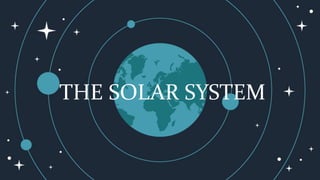
THE SOLAR SYSTEM
- 2. INTRODUCTION ☼ The Solar System is the gravitationally bound system of the Sun and the objects that orbit it. ☼ It was formed 4.6 billion years ago from the gravitational collapse of a giant interstellar molecular cloud. ☼ Over time, the cloud formed the Sun and a protoplanetary disk that gradually coalesced to form planets and other objects. ☼ The following planets are the part of Solar Family: Mercury Venus Earth Mars Jupiter Saturn Neptune Uranus
- 3. Formation And Evolution The Solar System was formed 4.568 billion years ago from the gravitational collapse of a region within a large molecular cloud. This initial cloud was likely several light-years across and probably birthed several stars. The cloud was mainly composed of Hydrogen, Helium, and small amounts of heavier elements fused by previous generations of stars. As the region that would become the Solar System, known as the Pre-solar Nebula, collapsed, conservation of angular momentum caused it to rotate faster. The center, where most of the mass collected, became increasingly hotter than the surrounding disc. As the contracting nebula rotated faster, it began to flatten into a protoplanetary disc and a hot, dense protostar at the center. The planets formed by accretion from this disc, in which dust and gas gravitationally
- 5. The Sun is the Solar System's star and by far its most massive component. Its large mass (332,900 Earth masses) and comprises of 99.86% of all the mass in the Solar System. The Sun is a population I star; it has a higher abundance of elements heavier than hydrogen and helium ("metals" in astronomical parlance) than the older population II stars. The Sun is composed of roughly 98% Hydrogen and Helium. It emits harmful Ultraviolet Rays (UV). The Sun
- 6. M E R C U R Y Mercury is the first planet from the Sun and the smallest in the Solar System. It is a terrestrial planet with a heavily cratered surface due to overlapping impact events. Distance from Sun: 58 million km Orbital period: 88 days Length of day: 59d 0h 0m Radius: 2,439.7 km Mass: 3.285 × 1023 kg (0.055 M⊕) Gravity: 3.7 m/s² Surface area: 74.8 million km²
- 7. V E N U S Venus is the 2nd planet from the Sun. It is a rocky planet with the densest atmosphere of all the rocky bodies in the Solar System. Length of day: 243d 0h 0m Orbital period: 225 days Gravity: 8.87 m/s² Radius: 6,051.8 km Distance from Sun: 108.2 million km Mass: 4.867 × 1024 kg (0.815 M⊕) Surface area: 460.2 million km²
- 8. E A R T H Earth is the 3rd planet from the Sun and the only astronomical object known to harbor life. This is enabled as it is a water planet, almost all of Earth's water is contained in global ocean, covering 70.8% of Earth's crust. Length of day: 24 hrs Orbital period: 365 ½ days Gravity: 9.8 m/s2 Radius: 6,371 km Distance from Sun: 149.6 million km Mass: 5.972 × 1024 kg Surface area: 510.1 million km² Natural Satellite: The Moon
- 9. M A R S Mars is the 4th planet and the furthest terrestrial planet from the Sun. The reddish color of its surface is due to finely grained Iron(III) Oxide dust in the soil, giving it the nickname "Red Planet". Distance from Sun: 227.9 million km Orbital period: 687 days Length of day: 1d 0h 37m Radius: 3,389.5 km Mass: 6.39 × 1023 kg Gravity: 3.71 m/s² Surface area:144.4 million km²
- 10. J U P I T E R Jupiter is the 5th planet and the largest in the Solar System. It is a Gas Giant with mass more than 2 ½ the other planets combined, and slightly less than one 1/1000 the mass of the Sun. Distance from Sun: 778.5 million km Orbital period: about 12 Earth years Length of day: 0d 9h 56m Radius: 69,911 km Mass: 1.898 × 1027 kg Gravity: 24.79 m/s² Surface area: 61.42 billion km²
- 11. Saturn is the 6th planet and the 2nd largest in the Solar System, after Jupiter. It is a gas giant with an average radius of about nine-and-a-half times that of Earth. Distance from Sun: 1.434 billion km Orbital period: 29.4475 years Length of day: 0d 10h 34m Radius: 58,232 km Mass: 5.6834 × 1026 kg Gravity: 10.44 m/s² Surface area: 4.27×1010 km² S A T U R N
- 12. U R A N U S Uranus is the 7th planet from the Sun. It is a gaseous cyan-coloured ice giant. Distance from Sun: 2.871 billion km Orbital period: 84.0205 yr Length of day: 0d 17h 14m Radius: 25,362 km Mass: (8.6810 ± 0.0013)×1025 kg Gravity: 8.87 m/s² Surface area: 8.1156×109 km²
- 13. N E P T U N E Neptune is the 8th and farthest planet from the Sun. It is the 4th largest planet in the Solar System by diameter, the third-most-massive planet, and the densest giant planet. Length of day: 0d 16h 6m Distance from Sun: 4.495 billion km Gravity: 11.15 m/s² Radius: 24,622 km Distance from Sun: 4.4726 billion km Mass: 1.02413×1026 kg Surface area: 7.6187×109 km2